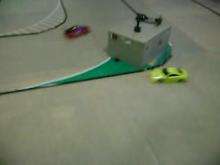Radio-controlled drifting

Radio-controlled drifting refers to the act of drifting with a radio-controlled car (R/C car). Special R/C cars are equipped with low-traction tires to aid in the ease of inducing and maintaining controlled oversteer. Car setups are often modified to allow the car to drift more easily, by replacing motors, shocks, tires, weight balance, brakes, and other factors. R/C drifting is typically performed with four wheel drive (4WD) electric R/C cars, although some practitioners use gas-powered (nitro) R/C cars and/or rear-wheel drive vehicles.
As a hobby, radio-controlled drifting is one of many variations of R/C car types and activities. Informal or formal practice events and competitions are held worldwide. When one judging R/C drifting competitions, R/C drifting typically follows the guidelines and judging criteria set by professional drifting organizations like the D1 Grand Prix. These judging criteria often include drift factors such as drift line, drift angle, speed, and show factor. Some R/C drifting competitions include the use of tsuiso or tandem-drift competition in which competitors are paired together to drift in a lead-chase format. This hobby was founded in Japan but has gained popularity in other countries.
Tires
Unlike R/C racing where rubber or foam tires are constantly changed and have short life spans, R/C drifting can be done with tires made of ABS plastic piping. ABS piping can be purchased pre-cut from various R/C drifting companies or one can also fabricate one's own tires with ABS piping purchased from a plumbing or hardware store. For 1/10 scale R/C vehicles, 2-inch-diameter (51 mm) ABS piping fits snug over the appropriate wheels for that scale vehicle. Drift tires can also be created out of white PVC piping due to the inherent frictionless behavior exhibited by PVC on concrete; however, the inherent white coloration of the material can be undesirable. Some users will paint these wheels to compensate.
Most pre-fabricated drift tires are made of rubber, plastic or polymers and come in many varieties of traction as well as tread. ABS tires last for hours, and PVC for longer, due to their physical hardness. Other types of plastics such as PVDF, PE, PP and their derivatives are also used due to their amount of traction and sliding combination. Fabricated drift tires are comparatively cheaper than manufactured drift tires. Manufactured drift tires promised a more realistic and controllable driving experience under certain circumstances. There are many makers of drift tires especially from Japan as the main source of RC drifting.
The development of tires within Japan itself is staggeringly fast compared to the rest of the world that have little access and yet couldn't relinquish its dependencies. This has reflected to less growth of development of drift tires either being use or make between the two sides. However, R/C drift is still a new art, and advances in the state of technology for drift tires are still in the works.
Customization
A notable aspect of R/C drifting is the creation and customization of the vehicle body or shell. Using paint, decals, and other craft type items some enthusiasts make replicas of their favorite real-world drift cars or come up with their own unique designs. Additional aesthetic modifications include LED light kits, ground effects, wide body kits, FMICs (Front Mounted Intercooler), decals, flared guards, and roll cages so they can achieve a realistic looking drift car. The aesthetics of painting one's own car is also a point of interest for some hobbyists. Some will go as far to create their own shells.
Another aspect in customization of an R/C drift car is the modification of the car's handling. Most R/C enthusiasts prefer of using "Countersteer conversion", a kind of drive ratio customization by means of changing the default front and rear gear/pulley settings (stock drive ratio is 50/50) to desired drive ratio (e.g. 30% in front drive and 70% in rear drive) to make a realistic drifts (usually seen of slower front drive and faster rear drive to make a rear wheel drive-like handling). However, some R/C companies doesn't support this kind of modification and doesn't give any qualification for their officially sponsored events because most enthusiasts can create this kind of modification from recycled parts (gear and pulley fabrication) or parts from third-party companies (e.g. a Yokomo pulley, used on Tamiya chassis which is actually not compatible but fitted through altering of parts), that makes the R/C car out-of-warranty; so most of the R/C drifting events are usually in open category.
References
Further reading
- SPH Magazines (February 2008). Torque. SPH Magazines. pp. 44–. ISSN 0218-7868.
- Bob Woods (1 September 2009). Wild Racers. Marshall Cavendish. pp. 11–. ISBN 978-0-7614-4389-6.